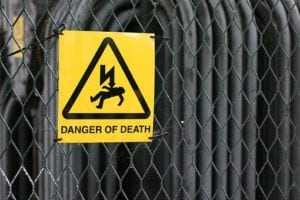 A lesson on situational awareness: The tones drop for a reported residential fire. On the way to the call, dispatch reports multiple calls, confirming a working fire. On arrival the crew sees fire blowing out the B-C corner of the single story, detached residential dwelling. The resident is standing in the front yard. A quick inquiry reveals they are dazed and confused about what is going on. They’re asked if anyone’s inside. They don’t know.
A lesson on situational awareness: The tones drop for a reported residential fire. On the way to the call, dispatch reports multiple calls, confirming a working fire. On arrival the crew sees fire blowing out the B-C corner of the single story, detached residential dwelling. The resident is standing in the front yard. A quick inquiry reveals they are dazed and confused about what is going on. They’re asked if anyone’s inside. They don’t know.
Almost reflexively training kicks in. The crew pulls a 1 3/4″ line while the company officer starts around the left side of the house to complete the 360 degree size-up. So far, everything is textbook. But things are about to change in a most unfortunate way.
As the engine crew gets the line charged and advanced to the front door they are met by the truck crew. The truck company officer announces the plan. The truck crew will enter and go right on the search. The engine crew will advance the hose line down the hallway to the back of the house to extinguish the fire and provide cover for the truck crew.
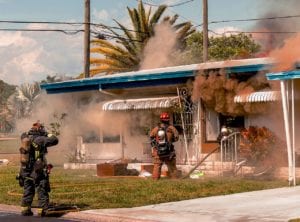 They open the front door and are immediately met by a blast of heavy, thick, black, angry smoke that is blowing out from the top of the jam to the bottom sill plate. The pressure forces the black fire out about six feet. The heat is intense. The firefighters belly-down and get to work. Because they’re firefighters. That’s what they do.
They open the front door and are immediately met by a blast of heavy, thick, black, angry smoke that is blowing out from the top of the jam to the bottom sill plate. The pressure forces the black fire out about six feet. The heat is intense. The firefighters belly-down and get to work. Because they’re firefighters. That’s what they do.
No one knows yet that two firefighters are going to get burned in just a few moments time in this environment. But it’s on their minds. At least it’s on the mind of the firefighter I interviewed.
Red Flags
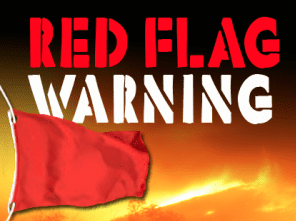 Hindsight is always better than foresight. Recall the mission of Situational Awareness Matters is to: Help you see the bad things coming… in time to prevent bad outcomes. In this case, the firefighter saw the bad things coming but it didn’t do anything to change the outcome. The Red Flags are the clues and cues that provide conscious (overt) awareness of what is going on or subconscious (covert) awareness of what is going on. The Red Flags are clues and cues that things may not be right for interior entry.
Hindsight is always better than foresight. Recall the mission of Situational Awareness Matters is to: Help you see the bad things coming… in time to prevent bad outcomes. In this case, the firefighter saw the bad things coming but it didn’t do anything to change the outcome. The Red Flags are the clues and cues that provide conscious (overt) awareness of what is going on or subconscious (covert) awareness of what is going on. The Red Flags are clues and cues that things may not be right for interior entry.
Red Flag #1: The size-up
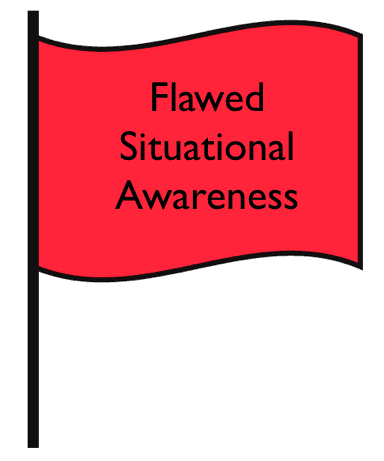 The company officer did not complete the 360 degree size-up. He started it. He went around the left side of the house and was met with so much heat and fire that he could not get between the two houses. Instead of going around the house to the right, he abandoned the 360 degree size-up. This would prove to be a mistake as the fire involvement on the rear of the structure was extensive. But he didn’t know it.
The company officer did not complete the 360 degree size-up. He started it. He went around the left side of the house and was met with so much heat and fire that he could not get between the two houses. Instead of going around the house to the right, he abandoned the 360 degree size-up. This would prove to be a mistake as the fire involvement on the rear of the structure was extensive. But he didn’t know it.
Red Flag #2: Hose line selection
 The firefighter thought the fire was large enough to need a 2 1/2″ line for attack. But he pulled the 1 3/4″ line instead. He later reported to me that he justified the decision in his mind by saying he didn’t want to waste the extra time it would take to get the 2 1/2″ line deployed. I have a different explanation for this behavior, but I’ll cover that later.
The firefighter thought the fire was large enough to need a 2 1/2″ line for attack. But he pulled the 1 3/4″ line instead. He later reported to me that he justified the decision in his mind by saying he didn’t want to waste the extra time it would take to get the 2 1/2″ line deployed. I have a different explanation for this behavior, but I’ll cover that later.
Red Flag #3: The interior conditions
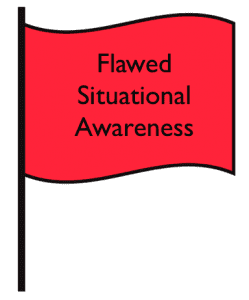 When the crew opened the front door they were met by (in his words) “A wall of black fire from top to bottom that was intensely hot.” He told me he’d never seen anything like it. Novel events (things we see for the first time) are some of the most difficult to reconcile under stress because the brain looks for familiar patterns that are sketched on our minds from past experiences. Novel events don’t “trigger” any pattern matches. No pattern match. No intuition.
When the crew opened the front door they were met by (in his words) “A wall of black fire from top to bottom that was intensely hot.” He told me he’d never seen anything like it. Novel events (things we see for the first time) are some of the most difficult to reconcile under stress because the brain looks for familiar patterns that are sketched on our minds from past experiences. Novel events don’t “trigger” any pattern matches. No pattern match. No intuition.
Red Flag #4: The go vs. no-go decision
 The firefighter truly felt this was a defensive (no-go) fire and entry should not be made. But when the captain announced the search crew was going to make entry, the firefighter felt obligated to provide for their protection. He told me later that had he refused to make entry and the search crew got hurt inside as a result, it would have ended his career on the spot. The risk of not entering was greater than the risk of making entry. So he said nothing and made the entry.
The firefighter truly felt this was a defensive (no-go) fire and entry should not be made. But when the captain announced the search crew was going to make entry, the firefighter felt obligated to provide for their protection. He told me later that had he refused to make entry and the search crew got hurt inside as a result, it would have ended his career on the spot. The risk of not entering was greater than the risk of making entry. So he said nothing and made the entry.
Red Flag #5: Inadequate water
 He was making his way down the hallway in zero visibility condition. He had his fog nozzle set on straight stream and was alternating between hitting the ceiling and hitting the base of the fire (though it was a fire that he could not see). He later told me he applied water as he had been trained. As he recalls, he flowed water constantly, which differs from how some firefighter are trained to apply water. He noted the water was doing nothing to cool the environment around him. He realized he was outgunned. He did not have the water to overwhelm the heat generation. But he didn’t leave.
He was making his way down the hallway in zero visibility condition. He had his fog nozzle set on straight stream and was alternating between hitting the ceiling and hitting the base of the fire (though it was a fire that he could not see). He later told me he applied water as he had been trained. As he recalls, he flowed water constantly, which differs from how some firefighter are trained to apply water. He noted the water was doing nothing to cool the environment around him. He realized he was outgunned. He did not have the water to overwhelm the heat generation. But he didn’t leave.
Unbeknownst to this firefighter, his back-up firefighter got so hot that they retreated back to the front door. The firefighter on the nozzle didn’t know this, leaving the firefighter alone in the hallway. Later the firefighter who retreated would explain that the plan was to get out of the environment for just a moment and then rejoin the firefighter on the nozzle.
Also unbeknownst to this firefighter, the truck crew was overrun by the heat and had already exited back out the front door. I asked the firefighter on the nozzle if he was aware the truck crew had exited (since this was, essentially, the only good reason for him to be holding his position against the fire). He wasn’t aware. He noted that if a message was transmitted over the radio to get out, he didn’t hear it.
Red Flag #6: The flashover
 Now he’s in the hallway alone. In fact, he’s the only firefighter remaining in the structure. But he doesn’t know that. What he does know is he’s losing the battle. But he doesn’t give up. There’s too much at stake. He tells me later that he could not give up providing the cover for the truck crew. He says he would have died there first. And that’s almost what he did.
Now he’s in the hallway alone. In fact, he’s the only firefighter remaining in the structure. But he doesn’t know that. What he does know is he’s losing the battle. But he doesn’t give up. There’s too much at stake. He tells me later that he could not give up providing the cover for the truck crew. He says he would have died there first. And that’s almost what he did.
The flashover happened in seemingly slow motion. He described it as a scene right from the movie Backdraft (though he laughed when he made the reference). “The flames came from above, rolling right down toward me. I thought to myself: This is not going to be good.” The heat was intense. He was getting burned. Reflexively, he turned his hose line toward the ceiling in an effort to cool the environment he was in. The flames retreated but it didn’t get any cooler. Now he was enveloped in zero visibility black fire and being baked by the steam he had generated. Each gallon of water he vaporized turned into 1,600 gallons of steam. He was in a bad spot.
He didn’t call a mayday. He didn’t have time. He was in the fight for his life. He didn’t think about dying. He didn’t have time.
The Rescue
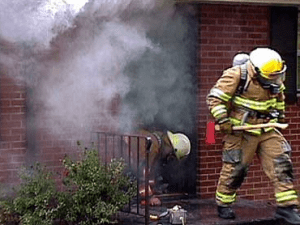 When the truck crew exited, the captain saw the back-up firefighter at the front door, preparing to enter again and rejoin the nozzle man. Instead, the truck captain made the entry, grabbed the nozzle man, now seemingly paralyzed on the hallway floor, and dragged him outside.
When the truck crew exited, the captain saw the back-up firefighter at the front door, preparing to enter again and rejoin the nozzle man. Instead, the truck captain made the entry, grabbed the nozzle man, now seemingly paralyzed on the hallway floor, and dragged him outside.
There, in the yard, lay a charred and (literally) smoking nozzle man. While everyone was out, a mayday was called because there were two firefighters down (albeit outside of the structure).
Hindsight
 In my interview of this firefighter, like so many others I’ve conducted, he told me that he saw the signs of dangers – “Red Flags” as he called them. There were many. He felt like they should not go in (intuition). But he ignored them all. He did not express his concerns to the captain. He followed his orders and did his job.
In my interview of this firefighter, like so many others I’ve conducted, he told me that he saw the signs of dangers – “Red Flags” as he called them. There were many. He felt like they should not go in (intuition). But he ignored them all. He did not express his concerns to the captain. He followed his orders and did his job.
The truck crew, making entry on the premise to search for victims, lasted about 30 seconds inside the structure. This is a pretty good (albeit a hindsight indicator) that it may have been a better decision to ventilate the gasses out of the environment prior to making such a high-risk entry. Further, it is very reasonable to assume that an environment that drives out seasoned firefighters wearing full protective gear is not an environment compatible with life for a civilian wearing street clothes.
Rich Gasaway’s Advice
 It is delusional to think a civilian who has spent minutes in an environment that drives out firefighters in just seconds can be saved. The chances that under such intense conditions firefighters would stumble upon a body (remember… the firefighters are only going to spend seconds in this environment before they are driven out), are very remote. If luck were on their side and they could drag the person out before being caught in the certain flashover, the body is removed. But the life is not saved. Second and third degree burns over 70+% of the human body are injuries incompatible with life.
It is delusional to think a civilian who has spent minutes in an environment that drives out firefighters in just seconds can be saved. The chances that under such intense conditions firefighters would stumble upon a body (remember… the firefighters are only going to spend seconds in this environment before they are driven out), are very remote. If luck were on their side and they could drag the person out before being caught in the certain flashover, the body is removed. But the life is not saved. Second and third degree burns over 70+% of the human body are injuries incompatible with life.
The story I shared above is true. I may have, inadvertently, made minor alterations or oversights in the details, but the core facts and the “Red Flags” are accurate depictions. I see this happening again and again. The definition of insanity is when we do the same things over and over again and expect the results to be different.
Does the fire ALWAYS flashover when the conditions are ripe for a flashover? No, there are no absolutes in an environment with so many uncontrolled variables. But when the conditions are right, to make entry is to dance with the devil. And, for whatever reason, dancing with the devil seems to be a favorite (and revered) trait of firefighters.
I am on a quest to understand what compels firefighters to ignore the clues and cues that form situational awareness. Why do some firefighters see the bad things coming in time to change the outcome… and defy the alarm bells and take the risk anyone. Is it because we’re firefighters and that’s what we do? Is it peer pressure? Is it ego? Is it the insecurity of having to live up to the macho persona we have made for ourselves? Is it inexperience? Is it fear of criticism from peers if we don’t? Or is it some element of all these things?
Action Items
 1. Discuss the need for a proper size-up. Figure out what’s going on before you start throwing around solutions.
1. Discuss the need for a proper size-up. Figure out what’s going on before you start throwing around solutions.
2. Discuss what “go” and “no go” conditions look like in advance of being at a scene where stress makes the decisions complex.
3. Discuss the conditions under which lives are savable and lives are not savable. It is important to acknowledge that not all lives are savable. The conditions have to be right and we have to arrive within a very narrow window of opportunity.
4. Discuss under what conditions it might be appropriate to ventilate heated gasses out prior to entry to improve visibility and survivability.
About the Author
Richard B. Gasaway, PhD, CSP is widely considered a trusted authority on human factors, situational awareness and the high-risk decision making processes used in high-stress, high consequence work environments. He served 33 years on the front lines as a firefighter, EMT-Paramedic, company officer, training officer, fire chief and emergency incident commander. His doctoral research included the study of cognitive neuroscience to understand how human factors flaw situational awareness and impact high-risk decision making.
_____________________________________________________

If you are interested in taking your understanding of situational awareness and high-risk decision making to a higher level, check out the Situational Awareness Matters Online Academy.
CLICK HERE for details, enrollment options and pricing.
__________________________________
Share your comments on this article in the “Leave a Reply” box below. If you want to send me incident pictures, videos or have an idea you’d like me to research and write about, contact me. I really enjoy getting feedback and supportive messages from fellow first responders. It gives me the energy to work harder for you.
Let’s Get connected
Facebook: SAMatters
LinkedIn: Rich Gasaway
LinkedIn: Situational Awareness Matters
Twitter: Rich Gasaway
Youtube: SAMattersTV
itunes: SAMatters Radio
Stitcher Radio: SAMatters Radio
Google Play: SAMatters Radio
iHeart Radio: SAMatters Radio

Been there done that, I would suggest a combination of facts, the strongest being protect the brothers, (you go we go type of thing). Afterword the stupidity of what was done was entirely evident. Only luck left no one injured.
Very well put, I’ve seen this happen time and time again over my career , that EGO thing gets them every time I have to say I was once one of those folks but with time has come knowledge and I try to teach that to those coming through the ranks today. It never hurts any of us to be reminded of the dangers we all face everyday . Thanks
Chief Gasaway,
Thank You! Your article will help me teach this lesson to our firefighters.
As you noted in the article: “Novel events (things we see for the first time) are some of the most difficult to reconcile under stress because the brain looks for familiar patterns that are sketched on our minds from past experiences. Novel events don’t “trigger” any pattern matches. No pattern match. No intuition.”
I would add this: This firefighter had the intuition (or a feeling) where did it come from? So how do you teach him to develop this pattern matching? By doing just what you are doing now. Training. We know we do not have enought fires to develop these skills. So read the articles, scan the magazines and ask questions (like the ones you presented in the article).
Even though there is no pattern match today it can happen over time with consistent training. This firefighter may not have realized it but the article he may have read, the cover of a magazine or some prior training may have given him that funny or uneasy feeling in his gut, sometimes that gut feeling is what you should be listening to.
Any time you have that feeling, you should take the time after the fire during the critique or during your own self evaluation of how you performed and why you chose to make the decisions you made. Try to match up conditions with those feelings and find out what triggered that feeling. This is how you build those mental pictures to draw upon.
Many times I hear: “I felt something wasn’t right or I didn’t recognize it, or I have never seen that before but I just couldnt explain why it didnt feel right”!
As trainers, we should help draw the picture of what may have caused those feelings an officer or firefighter may have had. We are then helping those individuals build their patterns.
Chief Gasaway… A tip of my helmet to you! Thank you for this great teaching tool.
Dan Rigdon
Assistant Chief
Central County Fire & Rescue
Chief,
Thank you for taking time to post a response to the article. It is by sharing ideas and experiences that we all learn more. I appreciate the time you gave to sending the great reply!
Rich
This is a great case study for firefighters and officers the world over to learn from.
I would also like to add that it is great to see someone tackling the difficult discussions that need to be had around traditional approaches to structural fire suppression, in particular size up and selection of a suitable strategy and adopting the appropriate tactics. Often a defensive attack is frowned upon as a “weakness” by some members of our firefighting fraternity.
Ultimately it comes down to this: Is the risk relative to the reward?
Answer this:
Can you as an Officer in Charge risk the lives of your crew, and risk husbands/wives and fathers/mothers never returning home to their families again, after a decision to mount an offensive attack sees them perish in a fire?
Well you can’t realistically answer that question until you have evaluated the reward (or lack of reward) that is at stake. If the building is so involved that anyone trapped would have certainly perished, or tomorrow when the fire is out, the bulldozers will arrive and knock whats left of the building down, then the answer is clearly no. No its not worth the risk pushing crews inside, because there is nothing left to gain. But if there is a window that due to the location and size of the fire and you have confirmed information relating to number and location of trapped people, then it may well be worth the risk.
This is where your size up becomes important, and in particular your questioning technique of bystanders and residents. The case study above mentioned a “quick enquiry”. Making a “quick enquiry” is like being invited to a friends place for an afternoon of free beer, and then only asking for half of the directions in how to find his house. You won’t get there unless you have ALL the information. Questioning technique is an important part of the OIC’s size up.
After your 360 and size up, consideration of the risk vs the reward, you select your strategy and tactics. As the fireground changes continuously, so should your consideration of the tactics employed. And once your crews have been deployed, review their effectiveness and continuously assess the risk they face next to the reward at stake.
Well done on your website Rich, as mentioned earlier – a great learning resource!
Regards from New Zealand,
Aaron
Aaron,
Thank you very much for posting your input on this article. I really appreciate the international perspective. You’re so right… how do we justify the decisions that cause firefighters to due. It was my fear of making just such a decision that launched me on the journey to uncover the barriers to situational awareness. I never wanted to look the family member of a firefighter in the eye and say “Your loved one isn’t here any more because I made a bad decision.” Just the thought of that haunted me.
Unfortunately, here in the states, we have some firefighters who are overrun by the macho persona that creating risk (versus assuming risk) is heroic. In some organizations the culture is broken. I so wish I knew how to fix it. I’m hoping that by sharing these articles and ideas we can all contribute to the solution.
It’s not uncommon for me to be verbally attacked when I call into question poor decision making that is driven by ego. Some act as if I am calling into question their courage. We have a long way to go.
Thanks for reading my stuff and sharing it along. I REALLY appreciate it.
Rich
P.S. I’m going to be in Australia in September presenting at the AFAC Conference in Melbourne. We are looking for companion programs in other states. So far we have interest in NSW, WA, Tasmania and Queensland. If you know someone who might be interested in hosting a situational awareness program while I’m there, have them send me an email (soon).
Great Post! Thank you for sharing usefull information. We are also provider of Safety Awareness Signs. Visit our website for more info highway1.co.nz